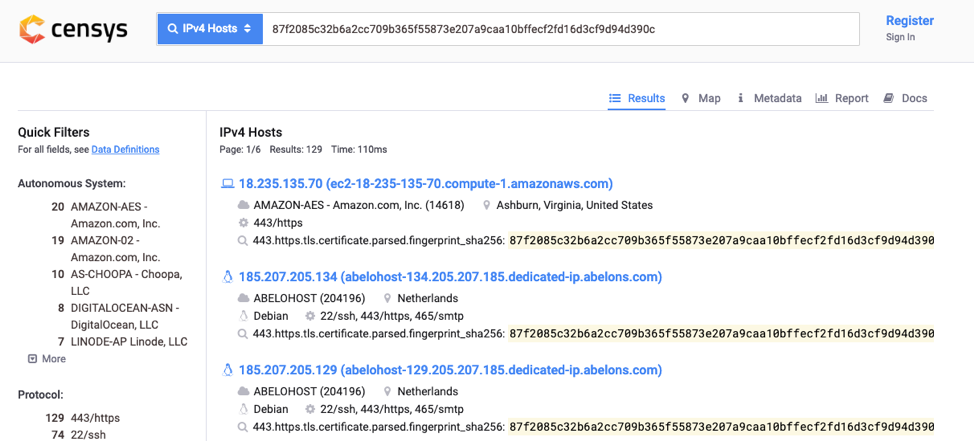From February 4, 2019 to February 15, 2019 Strategic Cyber LLC connected to several live Cobalt Strike team servers to download Beacon payloads, analyze them, and study the information within these payloads.
We conducted the survey from a system that exists separate of this company’s logs and records. The survey results were available on the same system. We did not use our logs or records to seed this survey.
We granted access to our survey system and results to a few parties we trusted. We did this to seek feedback on the data, process, and ideas for appropriate use. We also invited these parties to submit team servers for analysis as well. Unfortunately, one of those parties posted many domains from this system’s results to Twitter without our approval or knowledge. Some of these domains included red team infrastructure used by customers. While anyone could conduct the same survey, it was our system’s results that were used.
One of the top priorities at Strategic Cyber LLC is to not disclose or impact the red team operations or penetration tests of our customers. We see this aggregate and unapproved disclosure of domains, from our survey system, as undermining that goal.
The rest of this post details the survey process, what it extracted, and how to make your team server less visible to these types of analysis.
Why did we do this survey?
We conducted this survey as part of our continuous efforts to evaluate and improve our product controls.
How was the survey done?
We used techniques well-known in the blue community to identify Cobalt Strike team servers. We then connected to those servers to request a Beacon payload stage and analyzed its configuration and PE characteristics. We did not circumvent any technological measures to perform the survey.
What information does this analysis yield?
A lot of configuration information (necessary for the Beacon payload to function) is embedded in the Beacon payload DLL. Our analysis extracted hosts, URIs, User-Agents, and other behavior related configuration information. Our analysis also sought to identify: trial vs. licensed, authorization ID, version, and whether or not the product was altered in certain ways.

How did you find these team servers?
Here are the common techniques to identify Cobalt Strike team servers on the internet:
1) The Cobalt Strike product ships with a default SSL certificate for HTTPS communication. This self-signed certificate has no place in a live operation, but it’s still used in many Cobalt Strike deployments. One technique to find Cobalt Strike Beacon controllers is to search for the SHA-256 hash of Cobalt Strike’s default certificates:

2) Cobalt Strike’s DNS server (when it’s enabled) will respond to any request it receives with the bogon IP 0.0.0.0. A search for DNS servers that respond to an arbitrary DNS request with this answer will find Cobalt Strike systems. It will also find non-Cobalt Strike systems as well. It’s a noisy indicator.
3) Search for systems with port 50050 open. This is the controller for Cobalt Strike’s team server.
4) Another technique is to look for 404 Not Found root page with empty content and a text/plain Content-Type. This is the default response of Cobalt Strike without a redirector or content explicitly hosted at /.
How was the payload stage requested?
As part of its feature set and workflows, Cobalt Strike hosts the Beacon payload stage on its built-in web server. Cobalt Strike is compatible with the Metasploit Framework’s staging protocol. Any HTTP request that has the proper checksum8 value will yield a Beacon payload. Our system makes a request for a payload in the same way a Metasploit Framework stager would.
Protecting your team server
The process we used for our survey is nothing new or unknown. If you’d like to reduce the visibility of your team server to these mass analysis studies, here are a few tips:
1) Do not use the default HTTPS certificate within Cobalt Strike. If your goal is to emulate a low-tier actor with a self-signed certificate—use the https-certificate Malleable C2 block to generate a self-signed certificate that supports your exercise narrative. If you have a live operation, use a valid SSL certificate with your HTTPS Beacon.
2) The 0.0.0.0 is a well-known indicator of the DNS beaconing feature in Cobalt Strike. Use the dns_idle Malleable C2 option to change this to something else.
3) Edit the last line of the teamserver script to change the port from 50050 to something else. This is a very minimal measure. A better solution is to limit who can connect to this port with a host-based firewall.
4) If Cobalt Strike is hosting a Beacon payload stage, it will send payload stages in response to a valid request. This remains true, even if you configure the http-stager block in Cobalt Strike. The http-stager block reconfigures staging indicators within Cobalt Strike. It does not disable the compatibility with the Metasploit Framework. If you do not want Cobalt Strike to host a payload stage, set the host_stage Malleable C2 option to false. This option will require some changes to how you operate.
5) Use an Apache or Nginx web server as a redirector for your Cobalt Strike team server. Limit 80/443 connections to your team server to these redirectors. A properly configured redirector will smooth out indicators specific to Cobalt Strike’s web server (e.g., the JA3S fingerprint for SSL connections). A redirector is also an opportunity to serve legitimate content in response to non-staging and non-command and control URIs. The Red Team Infrastructure Wiki has advice on this topic.